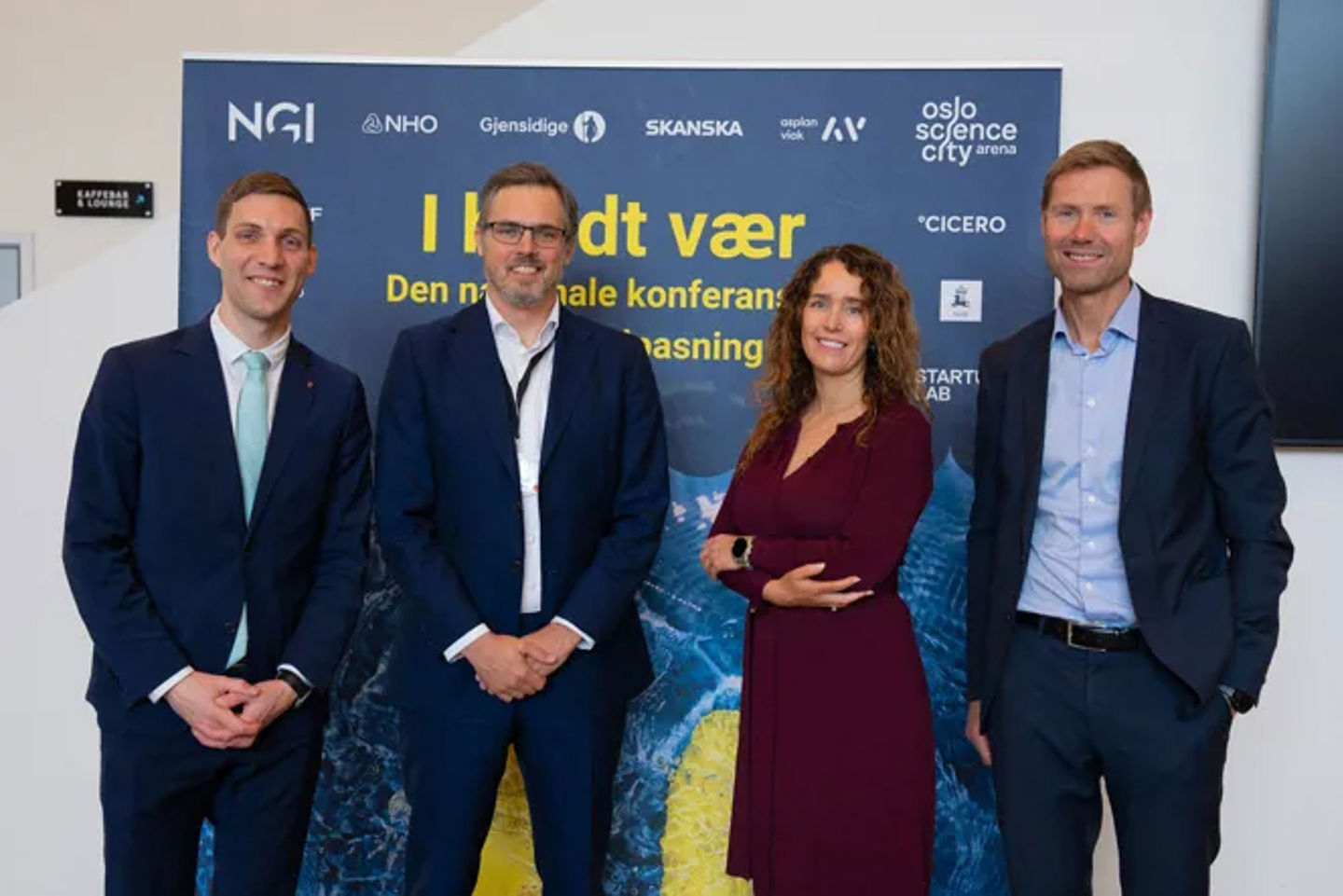Together to Climate-Proof Norway
How can we prepare Norway for future extreme weather? The National Conference on Climate Adaptation brought together 300 participants from various sectors and disciplines to find solutions.

NGIs CEO, Lars Andresen is greeting all the participants. ( Stian Thorvaldsen)
The urgency to accelerate work on climate preparedness and adaptation set the stage as more than 300 attendees from research, business, startups, and the public sector filled the hall on May 7 during In Harsh Weather (I hardt vær), the national conference on climate adaptation. This was an Oslo Science City Arena conference organized by NGI and Oslo Science City, in collaboration with Sintef, Cicero, NVE, the University of Oslo, Oslo Municipality, and Startuplab. Industry partners included NHO, Gjensidige, Skanska, and Asplan Viak.
Climate change increases the risk of floods, storm surges, landslides, extreme rainfall, and other natural hazards in Norway. Economic analyses by Menon Economics and NGI show that weather and natural hazard damage already costs NOK 5.5 billion annually in Norway, a figure projected to rise to NOK 19 billion annually by 2100 if new measures are not taken. The cost of securing existing buildings in Norway against floods and landslides by the end of the century is estimated at NOK 85 billion.
“To adapt to a harsher climate, we need to improve collaboration across disciplines and sectors. That's what we are trying to achieve with this conference. We've gathered a broad group of research communities and industry partners. There is a need for long-term strategic collaboration to prepare Norway for future extreme weather,” says Lars Andresen, Managing Director of NGI.
Preparing for Future Extreme Weather
Both Minister of Climate and Environment Andreas Bjelland Eriksen and Oslo City Council Leader Eirik Lae Solberg participated on stage during the conference. Bjelland Eriksen emphasized that Norwegian society faces a threefold challenge where we need to cut emissions, protect nature, and prepare for upcoming climate changes. Climate adaptation may not be the sexiest thing a politician can do, he joked, but the task is all the more important, and better coordination is a prerequisite for success:
“Weather and climate don't recognize sectoral responsibilities, so we must cooperate well and clearly distribute responsibilities,” the minister emphasized. Today, the political and practical responsibility for climate adaptation is divided among eight ministries and fifteen underlying directorates and public institutions.
City Council Leader Eirik Lae Solberg began by reminding how heavy snowfall this winter created significant traffic challenges in Oslo. At the same time, he pointed out that the capital has one of the most important resources to meet the challenges of a wilder and wetter climate: Knowledge.
“We have leading knowledge environments gathered in Oslo Science City, but we need to get even better at using this knowledge,” urged Lae Solberg from the stage.
Opportunities for Business
The audience also heard from some promising startups working to apply knowledge to develop new solutions: Companies 7Analytics, Mitigrate, and Celsia pitched their solutions from the stage and had stands in the networking area.
The need to involve the business sector more in the work on climate adaptation was also a main theme in Eric White's presentation, who leads the climate adaptation work at the World Economic Forum (WEF). In WEF's Global Risks Report for 2024, events related to the climate and nature crisis occupy the top four spots on the list of the greatest global risks over a ten-year perspective.
“We need to invite businesses more into the climate adaptation work and show them both the risks that climate change poses to them and the economic opportunities that exist in helping to find solutions,” said White.
Siri Hunnes Blakstad, Executive Vice President of SINTEF Community, led a panel discussion on the need for coordination and responsibility distribution in a field like climate adaptation, where so many different actors are involved.
“This is the decade where we must put climate adaptation on the agenda. It requires investments in both prevention and cooperation. A lot of work is being done on regulations for new buildings, but climate change is especially challenging for existing buildings. Perhaps it is not possible to secure everything either from a cost-benefit perspective. Going forward, we must therefore both communicate and collaborate,” emphasizes Hunnes Blakstad.
Vibrant Life and Good Conversations
For Lars Andresen from NGI, one of the highlights of the conference was seeing the vibrant life in the networking areas during the breaks:
“Here, we succeeded in creating a meeting place for municipal employees, contractors, researchers, advisors, entrepreneurs, and various other actors. This is important for successfully developing and applying the knowledge that Norway needs to face climate change,” he says.
Christine Wergeland Sørbye, CEO of Oslo Science City, says that the conference is part of a comprehensive effort in climate, energy, and environment in the innovation district. Just across the street from Ullevaal Stadium, NGI is now building Campus Ullevål, which will be completed in 2026. This will be a sustainability hub where they gather research environments, startups, and knowledge-based businesses in climate, energy, environment, community safety, and infrastructure.
“Analyses of the startup environments in Oslo Science City show that we have great potential to foster even more innovations and startups in climate, energy, and environment. The environments gathered at Campus Ullevål will be central to succeeding in this, together with, among others, Sintef and the University of Oslo,” says Wergeland Sørbye.

From the left we have the Ministry of Climate and Environment Andreas Bjelland Eriksen, Eric White from World Economic Forum, Christine Wergeland Sørbye from Oslo Science City and NGIs CEO, Lars Andresen. ( Stian Thorvaldsen)